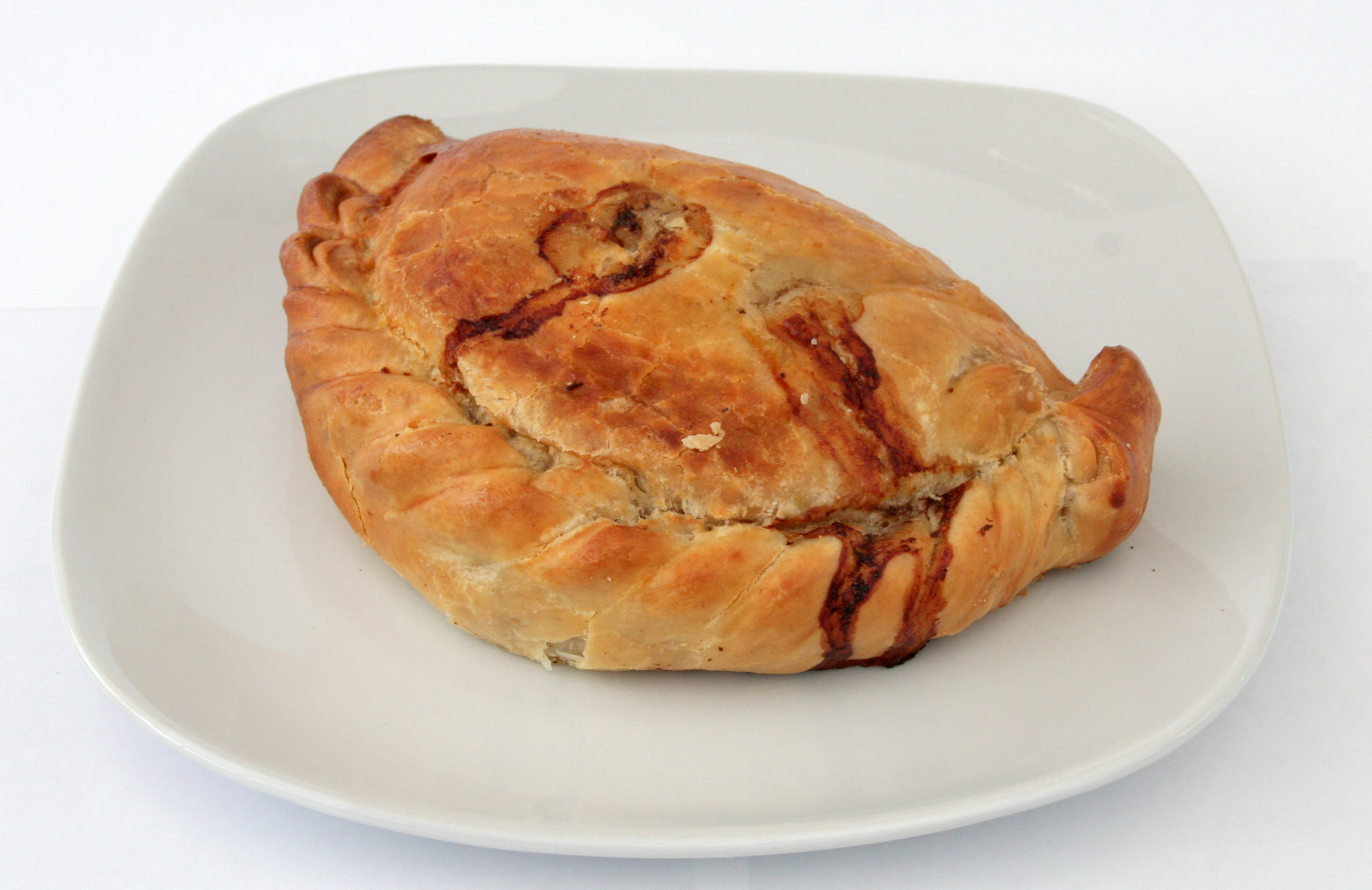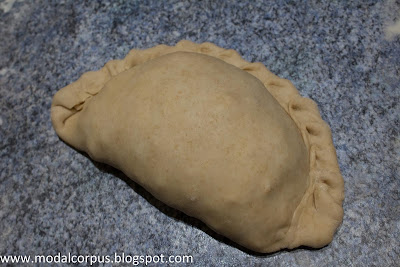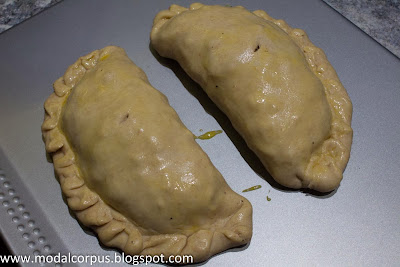I grew up in Cornwall, UK. I grew up with the smell of the sea in the air (my home is about 10 miles from the nearest coastline) and some of the tastiest food known to man. All of which I really really miss.
Some of the food I can't really replicate in Vienna: Austria being an utterly landlocked country means that fresh fish are pretty much a dream for me (smoked mackerel sort of does an ok job as a stand in). But I can make a pasty.
For those of you who don't know what a pasty is, it is a circle of pastry, filled with meat and vegetables, folded, crimped and then cooked in an oven for just under an hour. The pastry should be robust enough that the filling doesn't leak out, and it should be slightly flaky. They should be crimped on the side, and they should look a little bit like this:
 |
| Tasty! (image from Wikipedia) |
Pasties were awarded European Protected Status a few years back, which means that if you want to call a pasty Cornish, then it has to be made to a specific recipe, and be actually made within the boundaries of Cornwall. So although I follow the recipe for this tastiest of foodstuffs, I could never call it Cornish, because I make it them in my flat in Vienna.
One of the key ingredients of a pasty is swede (rutabaga). These are generally called neeps in Celtic nations, Cornwall being no exception. Unfortunately rutabagas are not generally considered worthy of eating in central Europe (not sure why not, damn tasty beggars) and are therefore hard to come by out here. Along with teabags, these are one thing that I ask people to bring me when they visit from the UK (you can also get them in Sweden; the name swede comes from their origin as a Swedish Turnip). Fortunately they store well in a cool dark place, as they are very woody vegetable, so I can store a bunch in my cellar.
All the other ingredients are easily obtainable in Vienna - beef (the correct cut is either chuck steak or beef skirt - in Austria skirt is called kochfleisch, but I normally buy gulaschfleisch which is from the rump as it is easy to get), potatoes and onions.
Making the pastry is actually easier in Austria, because there is a particular type of flour that is designed to release the gluten fast, for making strudel pastry. It is superb for pasties.
I did a little research into alternative pasty fillings the other day, as I want some variety, and if I can't get swede, what else could I use (believe me, a steak pasty doesn't taste right without a bit of swede). Despite the protected status of a specific recipe now, a pasty back in the day would have been made with whatever was to hand. Its origins are a more upper class dish, but eventually it became the food of the working class miner, and that meant that not every family would have been able to afford certain ingredients. Swede, onions and potatoes were probably fairly staple as they grow and store easily, but the meat would have varied. Pork and apple was apparently a popular filling, and I have read before about fish pastys being made in fishing communities (I had a fish pasty once, it was delicious).
So in the spirit of using whatever was to hand, when I made the pastry batch today I used up a load of flour that was hanging around my cupboard.
The great thing about pastys is that you can make them and freeze them without cooking, then you just take them out the freezer, pop them into a hot oven and bake for about 15-20 minutes longer than normal. They are the ultimate lazy lunch/dinner, perfect for the busy person. I won't pretend that they are particularly healthy, but you can make them healthier if you wish, in the spirit of using whatever is to hand.
For my pasty pastry I used:
500g flour - a mixture of wholemeal, wholegrain and white flour, roughly 50/50 wholemeal/grain to white. In the UK you need to use bread flour for the gluten content.
150g pork lard - the recipe calls for shortening, so if you want to make healthier pasties or veggie ones, you can use a plant based shortening.
10g salt
175ml water
1 egg - this is my addition, I find it makes for a better flake
The process is easy: rub the fat into the flour and salt (I find it easiest to do this bit in the food processor), then crack mix the egg into the water and use a knife to mix it into the flour/fat mix. Once you have it worked in as much as possible with a knife, get in with your hands and finish the job off. Give it a bit of a knead until you feel it become elastic (but seriously don't overwork the pastry, it isn't good), then wrap in clingfilm and stick it in the fridge for at least 4 hours to rest.
 |
| Ready to go in the fridge |
First prepare your filling. For the amount of pastry made above, you need about 450g beef, 450g potatoes, 250g swede and 200g onion. I don't get too precise, just roughly around those quantities.
 |
| Swede, potatoes and onion |
 |
| Lovely bit of beef |
Here comes the fun part. Roll out your pastry. Decide how big you want your pasty, and cut out a circle of pastry that will be about the right size. A dinner plate is a good template for a large pasty, the sort that you will eat for dinner. You want the pastry to be about 5mm thick.
Place your veg on the pastry, slightly to one side. Remember you're going to fold it in half. Then add a layer of beef on top.
Fold the pastry over the top of the meat and veg. Some places suggest using a rolling pin to support the free side, with practise you can do without. Squish the edges together, then you need to crimp the edges together to create a tight seal. Leaks are not desirable! This is an acquired skill, one that I am still practising - check here for some tips on how to crimp a pasty!
 |
| Fold the pastry and squish the edges together. |
 |
| Being careful not to stretch the edge, crimp the pasty. |
 |
| A pretty good crimp methinks! |
 |
| Knot at the beginning. |
Different people have different ways of cooking, but the way I do it is to cook in a 180 degree fan oven for about 40 minutes.
And there you have it. Beautiful golden pasties. Not necessarily the most EU friendly recipe, but a tasty little number all the same. In fact, was the best pasty I've ever made!








Now I know what a swede looks like haha. You hardly ever come across these in Poland as well, but if I spot any I'll give it a go, just out of curiosity. Perhaps it's something I need on my plate!
ReplyDelete